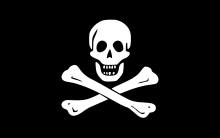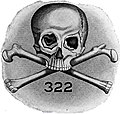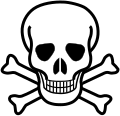Jolly Roger

The Jolly Roger or "the pirate flag ", often also the skull flag , is the black flag of pirate ships . It is also called Black Jack , based on the British Union Jack .
origin of the name
The origin of the name Jolly Roger is unknown. Some believe it is a corruption of the Indian pirate Ali Rajah, whose name the British pronounced Olly Roger; but it may also come from the French joli rouge (pretty red), as the first pirates hoisted a blood-red flag as a sign that they would kill everyone if the crew of the booty ship did not surrender immediately. In the stories with Peter Pan by the author JM Barrie (1860–1937), Captain Hook's pirate ship is called "Jolly Roger".
history
Flag of Calico Jack Rackham (* 1682; † 1720)
Emanuel Wynnes flag (late 17th century, early 18th century)
Henry Every's flag (* 1653 - † 1696)
Flag of Blackbeard (* 1680; † 1718)
Allegedly, Calico Jack Rackham is said to have used a black flag with a skull for the first time (variant with crossed cutlass), but this is not certain. The classic motif of Jolly Roger, a skull with two crossed bones, was first used by the Breton pirate Emanuel Wynne around 1700.
Henry Every's flag , last sailed in 1696, is depicted with a skull in profile, with a bandana and earring , over crossed bones. However, neither a skull in profile nor a bandana or earring can be found on flags or other heraldic symbols of the time. And although earrings, especially those made of gold, were not uncommon among sailors (the wearer hoped that the proceeds from the earring would pay him a Christian burial), the bandana and earring probably only became popular details of in the late 19th century artistic pirate representations, starting with the illustrated stories Howard Pyles (1853–1911).
On "Blackbeard" Edward Thatchs flag is a skeleton holding an hourglass and a spear in his hands, and beside a bleeding heart displayed. This should mean that the soul now belongs to death (skeleton). The hourglass is supposed to show the victims that their time is up. The spear promises a quick end, the bleeding heart a particularly cruel / painful death.
The skull with the crossed bones and the hourglass were - taken from older Vanitas - and Memento Mori - representations - widespread motifs in cemeteries. A proof can be found in the graphic cycle "The four stages of cruelty" by William Hogarth , published in 1751: The third picture shows the skull motif with crossed bones that adorns a grave.
Jolly Roger was first mentioned in Captain Charles Johnson's biographical collection A General History of the Pyrates in 1724 .
Worldwide there are still two authentic copies of a classic Jolly Roger with a skull and two crossed bones from the late 18th and early 19th centuries. One is in the Åland Islands Maritime Museum (Ålands Sjöfartsmuseum) in Mariehamn and the other in Portsmouth in the National Museum of the Royal Navy .
Flag of Thomas Tews († 1695)
Flag of Stede Bonnet (* 1688; † 1718)
Flag of Edward of England († 1720)
Flag of Bartholomew Roberts (* 1682; † 1722)
Other flags used as pirate symbols
The blood red flag (guess)
It is believed that a blood-red flag was used as a pirate symbol before the Jolly Roger. This is supported by the fact that until the advent of piracy in the 16th and 17th centuries, the red flag was used as a quarantine flag and meant "Warning, we may have a disease on board that will kill everyone who approaches us." And the pirates wanted to be fatal on approach. In addition, the quarantine flag was given a swallowtail in almost every seafaring nation in the 17th century , so according to the thesis, to avoid confusion with pirates. In any case, the British Navy forbade flying only red flags in the Arabian Sea, ships with such flags were treated as pirates; this is why the flags of Bahrain and Qatar still have their jagged shape today. In 1694 the Admiralty ordered that British privateers should fly the red flag. When the war against Spain ended in 1714, many of the then superfluous privateers went into business for themselves and also hijacked British ships while retaining their red flag.
One red and one black flag (guess)
According to other sources, the early pirates wielded two flags, of which they hoisted one as needed: the red flag was a sign not to take prisoners (i.e. to kill everyone) and the black flag to take prisoners for ransom. That is why the red flag was even more feared than the normal black flag, so joli rouge was a euphemism .
Asian pirate flags
The Jolly Roger, on the other hand, was unknown to the East Asian pirates. Around 1810 there were six large groups of pirates in the South China Sea who marked their ships with red and black, but also white, green, blue and yellow flags.
The pirates who are active today, especially in the waters around Indonesia , the Strait of Malacca and in the Arabian Sea , mostly refrain from waving flags to identify them as pirates.
Use and use at sea
Historical
As long as a pirate ship was looking for prey, it often ran under a false flag (flag of the victim / an ally of the victim) in order to be able to approach its victim undisturbed. The "Jolly Roger" was hoisted shortly before the attack in order to spread terror among the crews of potential prey ships before the actual boarding . It also signaled the pirates' contempt for death and their contempt for the sovereign insignia of other countries on the high seas.
Later the false flag tactic was also used by regular warships. For example, US ships are said to have hoisted the Union Jack in the Second Barbarian War in 1815 in order to be able to approach the flagship of the Algerian corsair Hamidu Reis , which was subsequently fought down. This unhindered approach was possible because the corsairs were at war with the United States of America, but not with Great Britain, whose flag is the Union Jack.
In modern navies

The Jolly Roger is still used by the British Navy to this day . If a submarine returns to its home port after the sinking of an enemy ship, the Jolly Roger is flagged on the tower; Stars and bars on them indicate the number of enemy ships sunk by the gun and torpedo. This last happened when the HMS Conqueror returned from the Falklands War in 1982 . The tradition was established during the First World War by the submarine commander and later Admiral Max Horton , when he arrived in Harwich on September 13, 1914 after the sinking of the German small cruiser SMS Hela and triumphantly hoisted the pirate flag. Today the Jolly Roger is also shown by the British boats that fired cruise missiles in combat conditions : first from HMS Splendid in 1999 after the Kosovo war , later from various boats that were involved in Operation Veritas and then from HMS Turbulent on April 16, 2003 after returning from the Iraq war .
In the US Navy , at least the use on board the USS Kidd (DD 661) has been handed down. In addition, several squadrons of US naval aviation used the Jolly Roger, the so-called "Jolly Rogers"; The name came about when the VF-17 squadron was equipped with F4U Corsair aircraft in 1943 .
Other current uses
The environmental protection organization Sea Shepherd Conservation Society has been flying a similar flag - with a trident and a shepherd's staff in place of bones, and a dolphin and a whale on the forehead of the skull - as a jack on their ships since the 1970s .
The Revolutionary Insurrectionary Army of Ukraine , an anarchist movement in Ukraine, used a black flag with the Jolly Roger to show their willingness to fight, and their contempt for death.
Adaptations
- In the 1980s, the logo of the Home Taping Is Killing Music campaign was based on the pirate flag.
- The fan scene of the Hamburg football club FC St. Pauli initially used the Jolly Roger as an unofficial club logo from the mid-1980s. In 1989, Steph Braun designed the St. Pauli skull with a combination of skull, crossed bones and St. Pauli lettering. The St. Pauli Totenkopf logo, registered as a trademark in 1996, was transferred to FC in September 1999 by Texmen Textildruck GmbH . St. Pauli sold. There is also a pub called Jolly Roger , which is an important meeting place for fans.
- The Jolly Roger Cooking Gang , founded by TV chef Stefan Marquard , has a Jolly Roger as its company logo.
- The logo of the punk rock band Die Toten Hosen is also based on the Jolly Roger.
- The "Pesthörnchen" or "Datenpirat" logo, originally designed by Reinhard Schrutzki for FoeBuD in 1990, represents an old Bundespost logo that has been mutated into a skull (still with telecommunication flashes), which was also used by the Chaos Computer Club .
- In 1967 the American company Williams Electronics Inc. brought a pinball machine called Jolly Roger with a pirate motif onto the market; a total of 3502 devices were produced.
- The American student fraternity Skull & Bones , founded in 1832, uses skulls and crossbones in its logo.
Home Taping Is Killing Music campaign logo
Skull flag of FC St. Pauli
Pest squirrels of the Chaos Computer Club
Fraternity Skull & Bones
Poison pictogram
There is no connection between the Jolly Roger and some Saudi Arabian flags , which, depending on the case, show a golden or silver palm or an anchor of the same color over two crossed swords on a green background.
literature
- Charles Johnson : A General History of the Pyrates. Great Britain 1724, ISBN 978-0-486-40488-2 .
- Richard Compton-Hall : Submarines at War 1939-45. Periscope Publishing, Folkestone 2004, ISBN 1-904381-22-7 .
- Bill Richards, Peter Smith: Onslow's Jolly Roger. In: Signals- Sydney 2006, ISSN 1033-4688 .
Web links
- Jolly Roger flags of various pirates
- Use of the Jolly Rogers with the US Navy (English)
- Jolly Roger at Flags of the World (English)
Individual evidence
- ↑ Published in 1903 as the collection "Howard Pyle's Book of Pirates".
- ↑ Archive link ( Memento of the original from January 15, 2008 in the Internet Archive ) Info: The archive link was inserted automatically and has not yet been checked. Please check the original and archive link according to the instructions and then remove this notice.
- ↑ In the collection "HA General History of the Pyrates" by Charles Johnson.
- ^ Richard Compton-Hall, Submarines at War 1939–45 , p. 62.
- ↑ Richards & Smith, Onslow's Jolly Roge , p. 11.
- ↑ Photo of the hoisting of Jolly Roger on the USS Kidd and background information on the use of this flag. Found in History of the USS Kidd, website of the USS Kidd and Veterans Memorial in Baton Rouge.
- ^ Origin of St. Pauli Totenkopf
- ^ History of Jolly Roger at FC St. Pauli
- ↑ Pesthörnchen: The origins of the Pesthörnchen ( memento of the original from February 1, 2008 in the Internet Archive ) Info: The archive link was automatically inserted and not yet checked. Please check the original and archive link according to the instructions and then remove this notice. on the website of Reinhard Schrutzki














